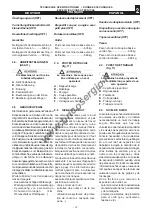
3.
PRECAUZIONI PER LA SICUREZZA • SAFETY PRECAUTIONS
ENGLISH
ITALIANO
- 40 -
After an initial bedding-in period or
many hours of operation, the driv-
ing belts may slacken; this causes
an increase in the tool stopping
time (the stopping time must be
less than 10 seconds). Immedi-
ately tighten them as described in
Chap. 7.
The working area around the ma-
chine must be kept always clean
and clear, in order to have an im-
mediate and easy access to the
switchboard.
Never insert materials which are
different from those which are pre-
scribed for the machine utilization.
The material to be machined must
not contain any metal parts.
Never machine pieces which may
be too small or too wide ithrespect
to the machine capacity.
Do not work wood which has evi-
dent defects (cracks, knots, metal
parts, etc.)
Use rollers or extension tables
when machining very large pieces.
Never place hands among the
moving parts and/or materials.
Keep hands clear from the tool;
feed the piece with the aid of a
pusher.
Keep the tools tidy and far away
from those not authorized persons.
Never employ cracked nor uckled,
neither not correctlyreground tools.
Only use tools in conformity with
EN 847-1
standard.
Never use the tools beyond the
speed limit recommended bythe
producers.
Carefully clean the rest surfaces of
tools and make surethat they find
perfectly horizontally positioned, and
withno dents at all.
Always wear gauntlets when han-
dling the tools.
Dopo un primo periodo di assesta-
mento o molte ore di lavoro, può
verificarsi l'allentamento delle cin-
ghie di trasmissione; questo pro-
voca un aumento del tempo di
arresto dell'utensile (il tempo di ar-
resto deve essere inferiore a 10
sec.). Provvedere subito al loro
tensionamento come descritto nel
cap.7.
La zona di lavoro attorno alla mac-
china deve sempre essere man-
tenuta pulita e sgombra per l’im-
mediato e facile accesso ai
comandi del quadro elettrico.
Non introdurre nella macchina ma-
teriale diverso da quello previsto
per il suo utilizzo.
Il materiale da lavorare non deve
contenere parti metalliche.
Non lavorare mai pezzi troppo pic-
coli o troppo grossi per la capacità
della macchina.
Non lavorare legni che presenta-
no difetti molto evidenti (spacca-
ture, nodi, parti metalliche, etc.....)
Utilizzare rulliere o tavoli di esten-
sione quando si lavorano pezzi di
dimensioni elevate.
Non mettere le mani tra le parti e/
o materiali in movimento.
Non mettere le mani in prossimità
dell'utensile; eseguire l'avanza-
mento del pezzo con l'aiuto di uno
spintore.
Custodire gli utensili in maniera
ordinata e lontano da persone non
addette.
Non impiegare mai utensili incri-
nati, deformati o non correttamen-
te riaffilati.
Usare esclusivamente utensili con-
formi alla norma
EN 847-1
.
Non usare gli utensili oltre il limite
di velocità indicato dai costruttori.
Pulire accuratamente le superfici
di appoggio degli utensili ed assi-
curarsi che siano perfettamente
piane e prive di ammaccature.
Maneggiare gli utensili utilizzando
i guanti di protezione.
www.bricosergio.it















































